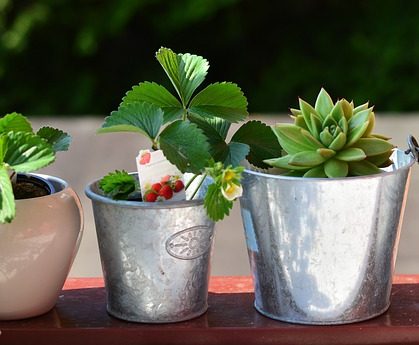Strawberries, who doesn’t just love that distinct, sweet taste? Especially when covered in fresh cream or blended into a smoothie with a touch of yoghurt. These iconic, little, red wonders are probably the most commonly grown berry in the UK, and with good reason.
For a start, they don’t need very much space at all to grow in, and can quite easily be grown in containers, or around the borders of your garden in plant containers. You can even grow them on a balcony of a flat if you don’t have a traditional garden.
Then there is the fact that after the first year of planting and taking care of the plants, they don’t need too much attention at all and will almost certainly give you a decent yield of those succulent, summer fruits.
Got your interest? Well, we hope so because in this article we are going to cover everything you need to know about how and when to plant strawberries in the UK.
When to plant strawberries in the UK?
The ideal time to plant strawberries in the UK is either in March to April, or later in the year between September and October.
Doing this will ensure that your Strawberries are ripened and ready to harvest in the late spring to late summer (June to September), depending on the variety of Strawberry you decide to go with.
Varieties of strawberry
The three main types of strawberry are ever-bearing, day neutral, and June bearing. To keep things simple, the main differences between the three types are how and when they bear fruit.
An ever-bearing strawberry plant will produce a lot of fruit early on in the harvesting season, then much less so until its later crop, which while is smaller than the initial crop, is still a good yield.

Day neutral strawberry plants produce fruit all the way through the growing season, but there are less berries and the berries themselves are smaller.
June bearing plants only produce one large crop of strawberries in the space of around two weeks, but this variety has the both the largest berries, and grows the most of them too.
How to plant Strawberries in the UK
The first thing to do is to get your soil prepared for planting. It doesn’t matter if you are going to be using runners, which resemble bare roots and a couple of leaves, or an actual plant from a pot that you’ve bought, this first step will be the same.
What you need is some compost or manure that has had time to rot a fair old bit, about 1.5 to 2 buckets worth for every square yard, and then digging it into your garden soil.
After this, you’ll want to add fertiliser to the soil, a decent all-purpose fertiliser will do just fine for this.

Now you need to make sure that the Strawberry plants will have enough space to grow. Your planting holes should never be any less than a foot apart, and a few inches more than this is what I would call ideal.
After you have dug your planting holes, you should take a look at the roots you are going to place into those holes. If they are looking a bit long, and by this, I mean over 10cm, you need to give them a little trimming down to size, and then make sure the roots are spread out inside the planting hole.
Something you have to be aware of, is that messing up the planting depth can lead to disaster, with the crowns of the plants dying off due to rot. Also, planting too shallow will cause the roots to dry out and again cause damage to the plant. So, be sure to keep the crown just above, or sitting on, the surface.
Where to plant Strawberries?
Strawberries are pretty versatile, allowing you to grow them in containers, or even grow bags as well as in garden soil. Before you go directly into soil though, it would make sense to check your soil quality.
You want strawberries in fertile soil, in a spot that gets plenty of sunlight and is sheltered from frost as much as possible. These plants will bear fruit with as little as 6 hours sunlight per day, but for best results, you want your strawberries in as much sunlight as possible.

If you have drainage problems with your soil, no need to worry, but it will probably mean you’ll end up using bags, containers, or maybe a raised bed to help with getting rid of the excess moisture.
In addition to not liking poorly drained soil, strawberries also suffer if there is a drought, so you have to keep up with the watering if this occurs.
Articles you might like:
Grow tomatoes all year round
Mini grow shed for tomatoes and can be used for strawberries too
Grow tents that can be used for strawberries
How to grow your own food
Vegetables you can grow easy
Problems that occur when growing strawberries
In addition to making sure that your strawberry plants don’t get damaged by frost, there are a number of other things to keep an eye out for such as powdery mildew, planting in soils that have previously had potatoes and other verticillium prone crops grown in there.
Powdery mildew can be avoided by planting in a spot that gets a lot of sunlight like we suggested in the last section.
Grey mould is a common problem with all kinds of fruit bearing plants and spreads more rapidly under humid conditions. It will also become more of a problem if you leave dead or infected plants, leaves, etc. lying around, so please stay on top of keeping the growing area as tidy as possible.
If you have a problem with slugs eating away at your strawberries, using some copper ribbon is usually enough to deter them, and some decent bird netting will stop our winged friends from getting a hold of the best of your crop.
We hope you enjoyed this short, yet informative article on how and when to plant strawberries in the UK, and invite you to spend a little more time on our site, exploring the many pages and articles, reviews and other content we have spent so many hours preparing for you.
